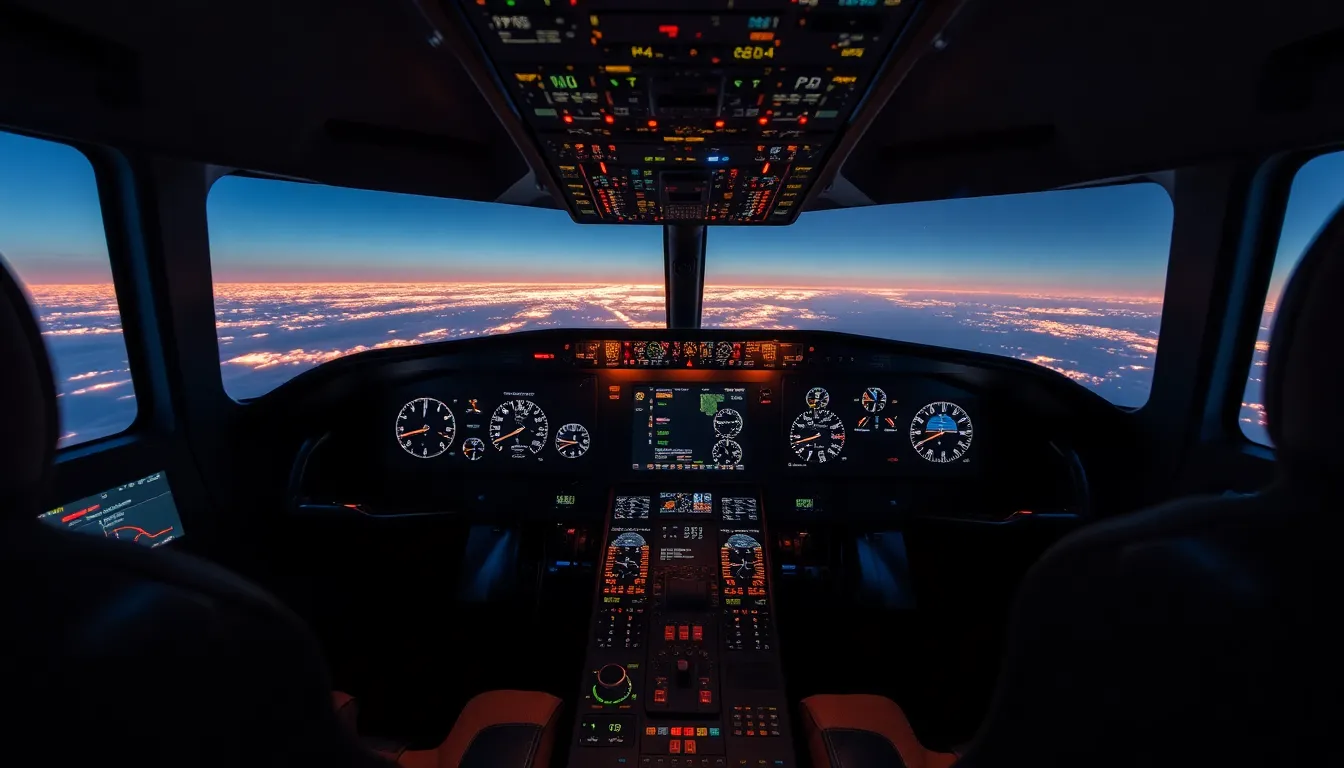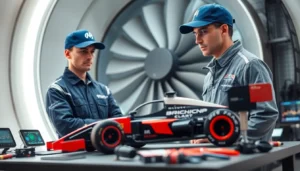Table of Contents
ToggleImagine soaring through the skies from the comfort of your living room, where the only turbulence comes from your cat jumping on your lap. The virtual cockpit view isn’t just a techy gimmick; it’s a game-changer that lets anyone experience the thrill of flying without the need for a pilot’s license or a fear of heights.
Overview of Virtual Cockpit View
Virtual cockpit view provides an immersive flight experience from the comfort of home. Users interact with realistic cockpit simulations, feeling as if they’re piloting an actual aircraft. Through advanced technology, this simulation captures the dynamics of flight while eliminating the need for a pilot’s license.
Various software options enable this experience. Flight simulators like Microsoft Flight Simulator and X-Plane stand out for their detailed graphics and user-friendly interfaces. Each program offers unique features, such as real-time weather adjustments and accurate aircraft models, enhancing immersion.
The appeal extends to avid aviation enthusiasts and casual users alike. Enthusiasts dive deep into flying mechanics and navigation systems, while casual users enjoy simply exploring different aircraft. Experience levels matter; beginners find comprehensive tutorials within simulators, easing their entry into aviation.
Real-time data integration enhances the virtual cockpit view. Tracking airport operations and flight paths provides authenticity. Developers incorporate updates to mimic changing conditions, allowing a more genuine flying experience.
The virtual cockpit fosters community engagement. Users connect through forums and social media platforms, sharing experiences and tips. Community-driven content often enhances base simulations, offering additional aircraft or routes.
Safety and accessibility become paramount in this setting. Aspiring pilots can practice procedures without risk while those with height phobias can still experience the thrill of flying. Virtual cockpit view democratizes flight exploration, making aviation more accessible.
Innovative hardware further elevates the experience. Equipment like yokes, throttles, and VR headsets enhance interactivity. These tools bring precision to the simulation, enabling users to engage with their environment seamlessly.
Features of Virtual Cockpit View

The virtual cockpit view offers various features enhancing the flight simulation experience. It focuses on interactivity, realism, and user enjoyment.
User Interface Design
User interface design plays a critical role in virtual cockpit view functionality. Intuitive layouts facilitate easy navigation, helping users quickly locate controls. High-resolution displays provide clear visuals, showcasing intricate cockpit details. Designers incorporate customizable dashboards, allowing users to arrange instruments according to personal preferences. Responsive feedback from touch or joystick inputs enhances engagement, improving overall immersion. Efforts to streamline the interface result in a seamless experience, ensuring that both beginners and experienced users can fully enjoy flight simulations.
Customization Options
Customization options empower users to tailor their experience in the virtual cockpit view. Users can select aircraft models from a broad range of available options, ensuring diverse experiences. Various control schemes, such as keyboard or joystick setups, enhance adaptability for different skill levels. Settings allow adjustments to instrument layouts, optimizing usability based on individual needs. Users can also modify environmental factors, including time of day and weather conditions, creating unique flight scenarios. Community-generated content enables further personalization, offering various additional aircraft and scenery packs for an enriched experience.
Benefits of Virtual Cockpit View
The virtual cockpit view offers numerous advantages for users seeking an immersive flight experience. Key benefits include enhanced driving experience and improved safety features.
Enhanced Driving Experience
Users gain substantial enjoyment from realistic cockpit simulations. A high level of detail in aircraft models captures authentic flying dynamics. Individuals engage in flight procedures familiar to real pilots, providing a sense of genuine accomplishment. Customization options allow selection of various aircraft types, enabling users to tailor experiences to their preferences. System integrations update real-time weather conditions, adding an extra layer of realism during flights. This adaptability caters not only to aviation enthusiasts but also to casual users exploring different flying scenarios.
Improved Safety Features
The virtual cockpit view eliminates risks associated with actual flying. Aspiring pilots can practice maneuvers without the fear of consequences. Additionally, beginners benefit from tutorials designed to build foundational skills. Individuals with a fear of heights find comfort in experiencing flying through a virtual medium. Real-time data integration simulates accurate airport operations, highlighting potential challenges pilots face. Engaging with this technology fosters confidence and competence before stepping into a real cockpit. Ultimately, the experience promotes a safer transition from simulation to real-world aviation.
Comparison to Traditional Cockpit Displays
This section explores how virtual cockpit views contrast with traditional cockpit displays.
Advantages of Virtual Cockpit View
Virtual cockpit views offer numerous advantages over traditional displays. Immersive engagement enhances the flight experience, allowing users to feel as though they are truly piloting an aircraft. Realistic graphics provide a lifelike environment that captivates users and enhances their understanding of aviation mechanics. Comprehensive tutorials specifically target beginners, easing their entry into flying simulations. Users also benefit from customization options, selecting various aircraft types and adapting to real-time weather conditions. Integration of real-time data tracks airport operations and flight paths, increasing authenticity in the simulation. Innovative hardware, including yokes and VR headsets, enhances interaction, providing a fulfilling experience for both enthusiasts and casual users.
Limitations and Challenges
Despite their many benefits, virtual cockpit views present limitations and challenges. Some users may experience motion sickness when using VR headsets, compromising their overall enjoyment. Hardware requirements can also be demanding, as high-quality simulations necessitate powerful computers. Learning curves exist, especially for new users who may find complex software interfaces difficult to navigate. Connectivity issues can disrupt seamless experiences, leading to frustration. Furthermore, reliance on virtual environments may leave some users unprepared for the challenges of real-world flying, particularly regarding emergency procedures and situational awareness. These factors can hinder the effectiveness of virtual cockpit views in fully simulating piloting experiences.
Future of Virtual Cockpit View Technology
Advancements in virtual cockpit view technology continue to reshape how users engage with flight simulations. Developers increasingly focus on creating more immersive environments that replicate real-world flying experiences. Enhanced graphics and improved software capabilities provide users with realistic cockpit interactions.
Emerging trends hint at the integration of artificial intelligence and machine learning, enabling more adaptive simulations. Personalized experiences will likely cater to individual preferences, adjusting scenarios based on user performance. The exploration of cloud-based solutions suggests that virtual cockpit experiences can become more accessible, requiring less local hardware to achieve high-quality simulations.
The use of virtual reality (VR) and augmented reality (AR) is set to expand, offering deeper immersion and interaction. Users can expect improvements in haptic feedback devices, further increasing realism during flight. Greater social integration within virtual cockpit platforms enables shared experiences, allowing users to fly together, regardless of location.
Safety training and educational programs may see enhancements through this technology, creating effective tools for aspiring pilots. The combination of realistic simulations with professional guidance can bridge knowledge gaps, preparing users for actual flying environments. At the same time, community support will continue playing a critical role in the evolution and refinement of virtual cockpit experiences.
Resilience against potential technical issues will also see ongoing development. Strategies to mitigate motion sickness, connectivity challenges, and hardware demands will remain priorities. Addressing these concerns ensures broader user adoption and satisfaction, allowing virtual cockpit views to thrive in the aviation simulation landscape.
The virtual cockpit view is transforming how individuals experience flight. With its ability to immerse users in realistic simulations it caters to both aviation enthusiasts and casual users alike. This technology not only enhances understanding of flight mechanics but also fosters a sense of community among users.
As advancements continue to emerge the future looks promising. Innovations in VR and AR will likely deepen immersion while addressing challenges like motion sickness. With ongoing developments in software and hardware the virtual cockpit view is poised to redefine aviation exploration making it more accessible and engaging for everyone.




